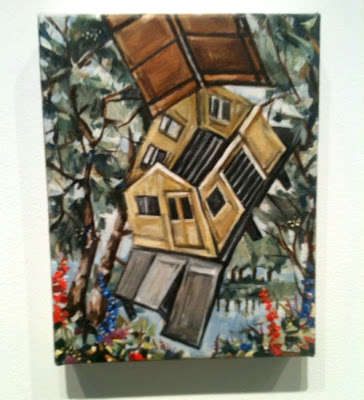Emily Campbell, Graduate School & An Edward Hopper Question
I received an intriguing comment on my last blog post, Edward Hopper's Women, from a reader wondering how much Hopper chose his style of painting? Mulling over how to answer I found myself thinking about Emily Campbell, the graduate student at the Maryland Institute College of Art who's been helping me teach my Life Drawing and Painting 1 classes. Above and below are some of the pieces Emily unveiled in her MFA Thesis show last Friday.
In the oil above a little house seems to fall to pieces as it flies up over a forest. It's the sort of image one could easily encounter in a dream. How Emily came up with it I'm not sure, but I know she has a collection of little dolls and toys that likely set her mind to weaving this tale for us. I like the painting quite a bit, largely for her unexpected and quirky details in the background. The foliage isn't naturalistic, rather it's giving us a particular gestural rhythm not unlike the patterns you'd see in a child's kaleidoscope. It's a forest unlike any I've ever seen before yet it seems the perfect accompanyment to the flying house. I imagine Emily fussed around for a very long time trying this kind of tree and that sort of branch until she arrived at the look that felt "right."
Below is a a half a horse teetering on a rocking chair. I know the arist sawed a toy horse in half to get it to fit on the chair. My guess is she tried the rocker with a whole horse and it just looked too improbable a combination. Now the hind legs of the horse get our full attention, and they seem right in step with the diagonals of the chair legs.
A final Campbell painting looks down at a castle surrounded by what look to be battlements and a moat. I think 9 out of 10 artists charged with painting a castle would have focused on the spindly towers and turrets. Emily focuses instead on a less obious direction- pentagonal battlements swell up to almost fill the canvas, pushing the blue waters of the moat into the most asymetrical and unanticipated shapes.
Emily has told me she works on her paintings a long time to get them right. Yet the works in her show aren't large and they seem to have a quick and brushy paint stroke. What's most likely is that these paintings go through myriad changes of all the tiny little shape ideas the artist invents, tinkering away until the vision gels. I was telling Emily at the opening reception how much her work strikingly reminded me of one of my favorite teachers in my own graduate painting program at Indiana University, Robert Barnes. Here's one of his oil paintings below.
What I got out of watching Barnes develop his paintings was the inordinate pleasure he took in the little things- the rhythms of the two fronds of leaves or the silhouettes of the puddles our running figures are racing over. I had come into graduate school in love with having "the big idea" for each of my paintings. I could manage a few bold strokes to suggest the bare bones of my story. But the backgrounds and empty spaces in corners just weren't considered important enough for me to have given them a thought. One of the things Barnes said to me in his very first critique of my work is "If the strokes show, they're part of the composition. Do more with your strokes."
Looking at Barnes' work I could see a level of playfulness and inventiveness with the little things. He'd make up these amazingly intricate little dance steps for his strokes and somehow get them all togther moving to the music.
I still am big on "big ideas" for paintings. But in my graduate school I learned to find richness and expression in the little moves and supporting characters in the paintings. Looking at Barnes' work now it strikes me as the fruit of a man who wants to be very generous to his viewers. I try hard to do the same. And I sure mess around with my brushstrokes for hours until some magic starts to happen.
It's been a real pleasure working with Emily in my classroom these last two years. And it's been very satisfying to watch her grow as a painter over that same time. Here below is Emily and me at the opening. I'm carrying an empty dinner plate which I told people was a prop in my soon-to-burgeon career as a performance artist. Actually it was the plate Emily had brougth to our painting class that morning with cookies she's made to make up for missing the previous class (when she was frantically finishing off her paintings for the exhibition).
I didn't get to sample any of the cookies (undergraduate art students move very fast in such situations). But despite that, I thougth Emily Campbell's paintings were the stars of the Graduate Thesis Shows. In a couple of days I'll be posting some more thoughts on the whole question about Edward Hopper's painting style and how it flows from their mode of invention. Maybe I'll eat some cookies before I write the post.







